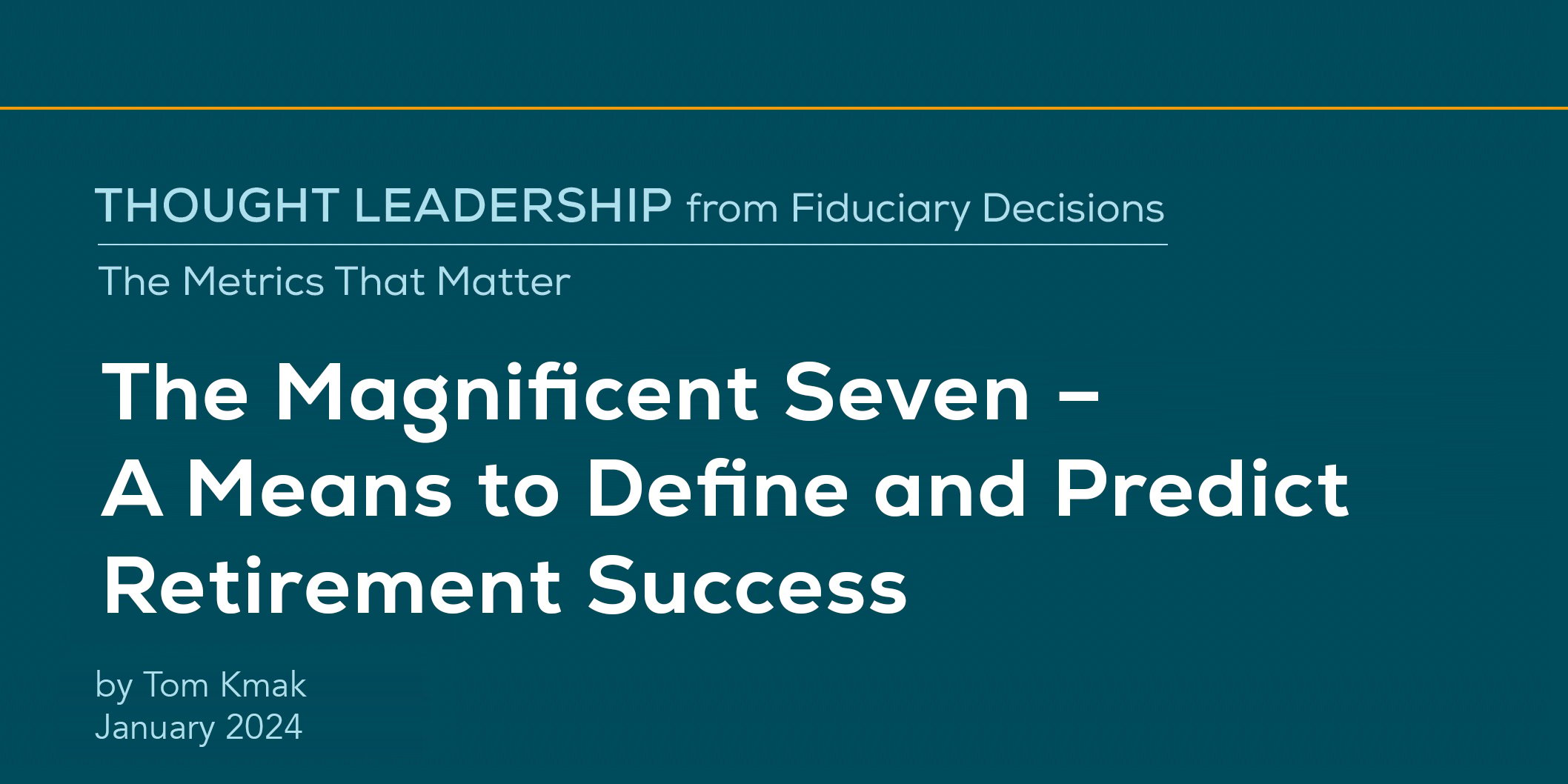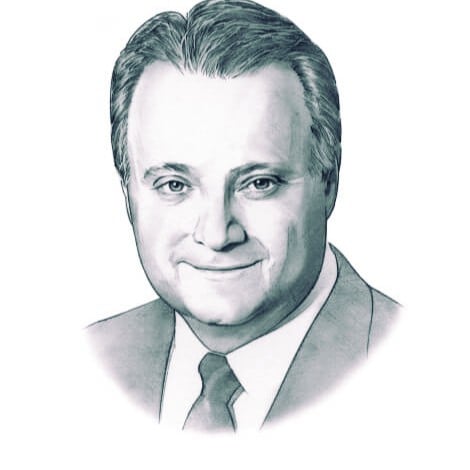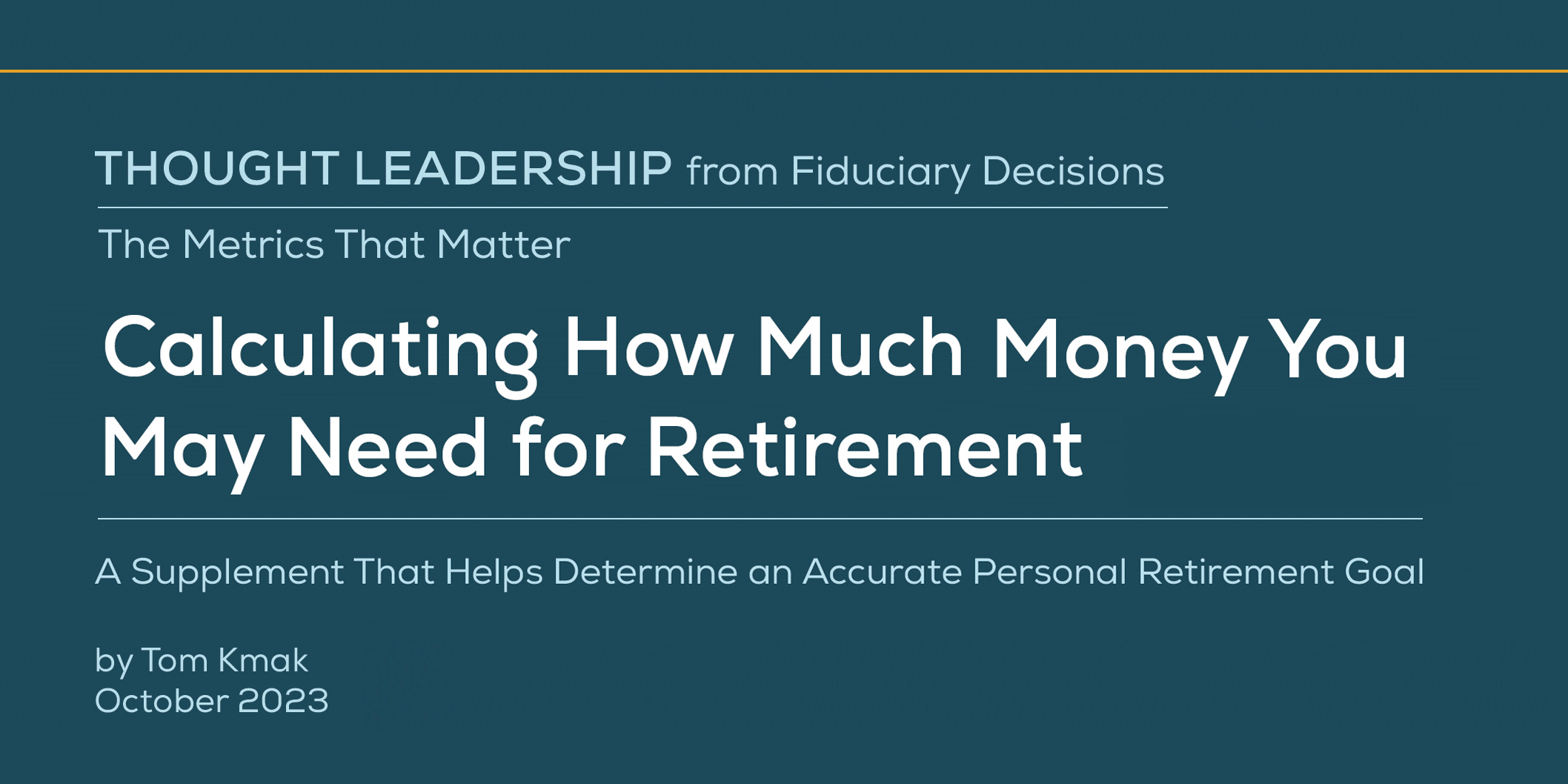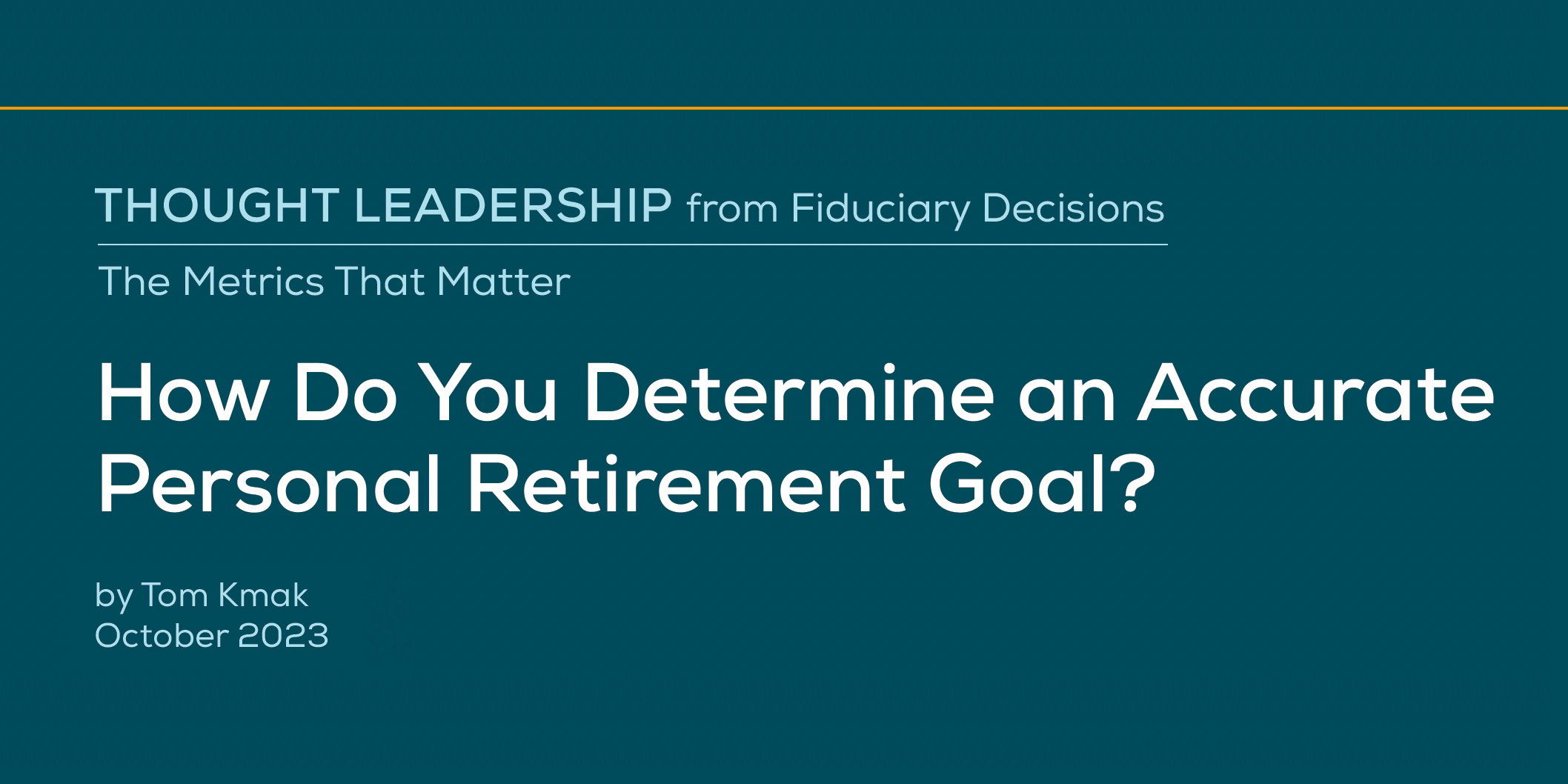The Magnificent Seven – A Means to Define and Predict Retirement Success
by Tom Kmak, Chief Executive Officer
Dec 28, 2023

In our first “The Metrics That Matter” article, we discussed the ultimate “what is winning” goal for the retirement industry: the setting and achieving of a Personal Retirement Goal (PRG) which involves asking each individual participant two questions:


The Personal Retirement Goal is number seven of the Magnificent Seven — the key metrics we believe help determine retirement success. The PRG “what is winning” metric is known as a Lag Indicator. The business book, The Balanced Scorecard introduces the concept of “Lead Indicators,” which PREDICT the achievement of the Lag Indicator.
The concept of “what is winning” is known as a Lag Indicator from a very famous business book: The Balanced Scorecard, by authors Robert S. Kaplan and David P. Norton. For a good synopsis of this concept, as well as nine other legendary business concepts, I highly recommend the book from Harvard Business Review published in 2010.
– HBR’s 10 Must Reads: The Essentials ($13 on Amazon).
While “what is winning” is known as a Lag Indicator, The Balanced Scorecard introduces the concept of “Lead Indicators,” which PREDICT the achievement of the Lag Indicator.
Now let’s discuss the six other metrics which make up The Magnificent Seven
There are six metrics you can monitor that will tell you whether savers are marching toward “winning” their retirement goals. To us at Fiduciary Decisions, the lead indicators are:
1. The Percent of Participants that have set an Individual Retirement Goal
2. The Participation Rate
3. The Deferral Rate
4. The Percent of Participants Maximizing the Employer Matching Contribution
5. The Percent of Participants “Professionally Invested”
6. The Percent of Participants NOT cashing out their 401(k)/403(b) balance when they change jobs
In each case, the higher the percentage, the higher the likelihood of plan participants reaching their personal retirement goals.
![]() The Importance of Disciplined Savings and Investing
The Importance of Disciplined Savings and Investing
To reinforce the correct concept of “what is winning” for our industry, a recent article noted participants are now trying to figure out how to retire at age 63. Since almost everyone reading this article has a “normal” retirement age of 67, this reinforces the need to elicit from each participant, one at a time, THEIR desired retirement goal, both the desired age and the desired income. To all those service providers out there who are helping participants achieve a sound retirement, I am reminded of a quote from Dave Ramsey: “You must gain control over your money or the lack of it will forever control you.”
Six Simple Measurements with Profound Impacts
Let’s examine each of these in a bit more detail by focusing on what they mean for each individual participant:
- The Setting of an INDIVIDUAL Retirement Goal. Remember the prescient words of the Cheshire Cat in Alice in Wonderland: “If you don’t know where you are going, any road will take you there.” So, if the participant does not tell you what their goal is, it’s going to be awfully hard to determine if they reached it.
- The Participation Rate. It is without a doubt true that most people save at their place of work. About 70% of full-time workers have access to a retirement plan and about 70% who have access actually participate. While our firm is one that helps fiduciaries determine the reasonableness of fees, the examination of those fees must be accompanied by value. After all, how do lower fees help someone who is NOT in the plan?
- The Deferral Rate. While higher deferral rates indicate a healthier plan, be careful not to obsess over getting to 15% or some other high number. In fact, I was pleased to see an article recently about people saving too much. After all, if you save so much you can retire at age 60, but you really want to keep working to 65, did you put off some “Adventures” you could have had with your loved ones when you were 40 because you were so focused on your retirement?
- The Percent of Participants Maximizing the Employer Matching Contribution. As people have said for many, many years, employer matches are akin to free money. In a healthy plan, employees are encouraged to maximize this match and a high percentage do. Some 62% of employees say the employer match is key to their reaching their retirement savings goals.
-
The Percent of Participants Professionally Invested. Even a decade ago, an Aon study found that professionally managed accounts performed 3.3% better annually (and 75% better over the life of the account) than non-managed accounts. If we have learned anything in this industry over the last few decades, it is that most people don’t have the time, aptitude or attitude to be a professional investor. Let them leave it to the professionals running Target Date Funds or Managed Accounts so they can concentrate on something equally or even more important, such as their children’s baseball game or dance recital.
- The Percent of Participants NOT Cashing Out Their 401(k)/403(b) Balance When They Change Jobs. The DOL estimates that people will change jobs an average of 5.7 times. It is critical that each time you change your job, you rollover the monies from your prior plan to avoid paying federal and state taxes — not to mention the 10% excise tax penalty associated with accessing that money before retirement.
As an interesting anecdote, I recall one employer way back in the late 1980’s that wanted to know which employees were NOT contributing 6% for his company’s 401(k) plan which had a 100% match up to 6% of pay (pretty generous back then). At first, I thought his actions were magnanimous as he wanted to persuade them to not give away free money. But it turned out I was wrong. Instead, he wanted to know who they were so he could fire them as he thought they were not smart enough to work for his company if they gave away that much free money.
Consider Each Employee as an Individual
While these impact indicators are percentages of a plan’s participants, the most successful plans provide assistance one employee at a time, based on that particular employee’s retirement goals. These successes — and measurements — roll up to percentages of total participants.
I do not recommend cohort analysis. You will note that none of the above references an age cohort of 25-to-35-year-olds, or an income cohort of people making $100k to $150k per year, or those that have been with the firm for 5 to 10 years. Cohort analysis has always struck me as arbitrary. After all, why is the age cohort 25 to 35? Why not 21-to-30 or 20-to-25? In the end, the ultimate cohort is a cohort of one: speaking to one individual at a time.
The Bottom Line
If service providers, plan sponsors and participants pursue the six metrics shown above, there is a much greater chance participants will achieve their retirement goals.
For a quantitative example of how these “6 Lead Indicators” can impact someone’s retirement, please click here.
About Author:

Tom Kmak, Chief Executive Officer
Tom Kmak is the co-founder and Chief Executive Officer of Fiduciary Decisions (FDI, formerly Fiduciary Benchmarks). During his 16 years with the firm, FDI has become the industry’s leading firm for benchmarking retirement plans using a patented approach that recognizes the mathematical truth that “Fees Without Value is a Meaningless Comparison.” Tom is pleased to say that FDI’s benchmarking service is used by 70% of the largest and most prestigious Recordkeepers as well as over 60% of the best Retirement Plan Advisors as recognized by various industry publications. Tom has also been involved in the development of other services at Fiduciary Decisions, such as the Rollover Decision Support System supporting DOL PTE 2020-02, as well as the interactive plan design tool called the Retirement Outcomes Evaluator.
Prior to founding FDI, in 1990 Tom started the JPMorgan Retirement Plan Services business with American Century. Upon leaving in October 2007, that business employed 1,100 people serving two hundred large plan sponsors with over 1.5 million participants and more than $115 billion in assets. During his career with Retirement Plan Services, the company initiated numerous industry firsts including no blackout conversions and the innovative employee education program, Audience of One. Tom also served on the Executive Committee for JPMorgan’s asset management business.
Tom graduated Phi Beta Kappa from DePauw University with B.A. degrees in Economics and Computational Mathematics. He was the first graduate of the Management Fellows Program and a 3-year letterman in inter-collegiate basketball.



